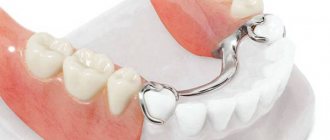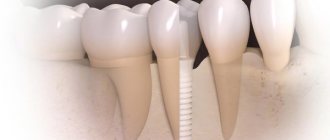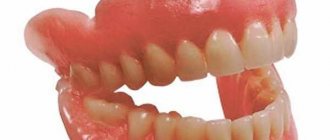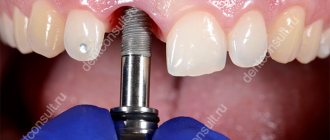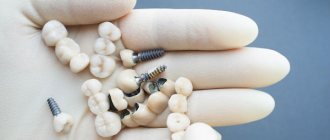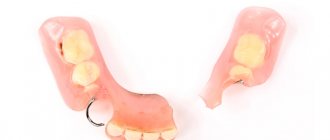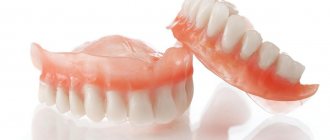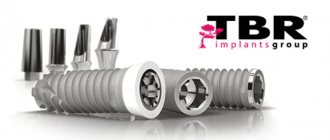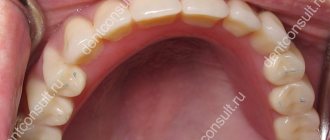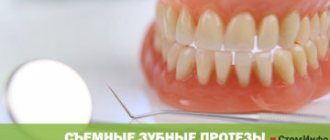16.05.2018
2231
Sign up for a free consultation:
- 1 Why do allergies occur?
- 2 How does an allergy to an implant manifest itself?
- 3 Features of reaction to various alloys
- 4 How to get rid of allergies to implants?
The procedure for dental prosthetics is one of the most expensive in orthopedics. Therefore, the doctor tries to minimize any complications, carefully prepares each stage and selects high-quality materials. But 4 out of 100 patients encounter a problem that simply cannot be predicted - an allergy to a dental implant. This is a specific reaction to various materials that can worsen the health of the entire body. Its symptoms can be very vague and appear after a long time.
How does an allergy to a dental implant manifest itself?
An allergic reaction to a dental implant is a fairly rare occurrence in our time.
Modern dentistry mostly uses bioinert materials for the manufacture of implants, primarily gold and titanium. But despite this, chromium-cobalt alloys, alloys using stainless steel or nickel are still in use. They cause an allergic response of the body much more often than theoretically, titanium or gold, which are absolutely inert towards the body. In practice, an allergy to an implant is determined by the following patient symptoms:
- Swelling and bleeding in the implantation area for more than 2 days after implantation.
- Redness at the location of the implant, pain when touched.
- Acute pain when chewing food.
The same symptoms also appear when the implantation site becomes inflamed as a result of infection, improper care and non-compliance with hygiene rules.
An allergic reaction is necessarily accompanied by other manifestations that are not at first glance related to the implant itself:
- Redness.
- Hives.
- Swelling (primarily of the face)
- Itching.
- Rash.
- General deterioration of the body's condition.
This is the most common list of metals used in modern dentistry.
Therapy methods
Conservative treatment with medications is carried out for acute reactions and complications. At the initial stage, if you contact a specialist in a timely manner, it is enough just to eliminate the source of the allergy - the installed prosthesis.
It should be taken into account that after the procedure, slight hyperemia in the area of the operation may persist for 2 days. It is recommended to limit the load on the implant and observe hygiene rules.
At the initial stage of osseointegration of the structure, patients prone to allergic reactions will need to adhere to dietary nutrition. The following foods should be excluded from the diet: nuts, legumes, citrus fruits, chocolate, tomato, mushrooms, pears.
In severe cases, with severe symptoms and difficulty breathing, the doctor prescribes antihistamines (Suprastin, Tavegil, Diazolin). The course of administration and dosage are determined individually, based on the characteristics of the body and the patient’s condition.
Prevention of the development of allergic reactions to dental implants will include a correct daily routine and diet, compliance with doctor’s recommendations and a healthy immune system.
Algorithm for the development of allergies to implants
The mechanism of development of this type of allergic reaction is as follows:
- The metal implanted in the jaw comes into contact with body fluids and corrodes.
- Metal salts (iron, cobalt, etc.) dissolved in biological fluids play the role of electrolytes.
- Ions are released that can form organometallic complexes with body proteins. An allergy to a dental implant appears.
The duration of this process is usually 3-7 days.
Dental implant failure occurs in approximately 10% of cases after a dental prosthetic procedure. The average survival time of installed structures is about 3-4 months in the mandibular area and about six months in the upper area.
Such features of osseointegration (fusion of metal roots with bone) are explained by the fact that a large load falls on the lower part of the facial skull. The bone structures in this area are stronger and better supplied with blood.
The healing period after implantation depends on the quality of manufacture and model of the orthopedic device, regardless of the installation method.
There can be several reasons for implant failure. Factors associated with the work of a doctor are as follows:
- incorrect selection of prosthesis;
- overheating or injury during installation;
- failure to comply with antiseptic measures;
- improper preparation;
- insufficient volume of bone structure;
If implant rejection occurs due to the fault of the prosthetic specialist, the process is observed in the first days after implantation.
The reason is also called the characteristics of the patient’s body at the time of the procedure or existing diseases:
- High sensitivity to the presence of a foreign body – allergy to dental implants.
- Low immunity.
- Chronic pathologies in the acute stage.
- The presence of untreated teeth with cysts or other foci of inflammation in the vicinity of the implant.
- Anatomical features of the jaw structure.
- Increased load on the prosthesis.
Also, the patient himself often does not follow the doctor’s recommendations, which causes rejection of the dental implant:
- violation of nutrition rules;
- uncontrolled use of antibacterial drugs;
- visiting a sauna or bathhouse immediately after surgery;
- poor oral hygiene;
- independent refusal to take medications;
- smoking;
- lack of preventive examinations at the dentist.
The most dangerous complication of implant failure is peri-implantitis. This is an infectious tissue lesion, up to bone resorption at the site of the structure.
Such inflammation of the dental implant is associated with the low quality of the prosthetic prosthesis and technical errors of the doctor who must implant orthopedic devices.
TITANIUM INTOLERANCE - TITANIUM INTOLERANCE. ALLERGY TO TITANIUM.
Titanium has outstanding properties, which means that, compared to other metals, it is well tolerated immunologically.
However, it is known that in 26% of patients, implants cause adverse signs of inflammation, which lead to:
- lack of bone integration of implants,
- failure to engraft a dental implant,
— rejection of dental implants in the first 6 weeks after implantation
— rejection of dental implants within one to five years after installation
- peri-implantitis.
True cellular allergies of type IV to titanium are rare compared to other metals. The reason is that titanium ions have a high affinity for oxygen and therefore form oxides immediately after their release, and unlike free ions, these oxides cannot form protein bonds and therefore allergic effects cannot develop.
The often heard statement that “there is no allergy to titanium” is quite likely true from an immunological point of view. However, allergies are not the only cause of immunologically related intolerance. The most common cause of individual hypersensitivity to titanium is excessive proinflammatory reactivity of tissue macrophages. Macrophages are special cells of the body that are responsible for protecting humans from foreign substances and bacteria.
Titanium particles in the tissue cause an inflammatory response, which leads to implant rejection.
Studies have shown that titanium particles are always found in the bone and soft tissues surrounding the implant. Tissue macrophages ("scavenger cells") phagocytose (ingest) these titanium oxide particles (particulate matter). As a result, a physiological response of the patient's tissues to the implantation occurs, such that macrophages react to contact with titanium oxide particles by releasing pro-inflammatory cytokines, in particular TNF-α and interleukin-1.
However, the extent of this immune response is very individual.
The intensity of cytokine release depends on the genetic variants (polymorphisms) of the proinflammatory (IL-1 and TNF-α) and anti-inflammatory (IL-1RN) mediators involved.
Therefore, titanium intolerance usually results from an increased propensity of tissue macrophages to become inflammatory in response to titanium oxide particles. Titanium-specific lymphocytes do not play a role here, which explains the negative results of LTT and the results of the skin test.
Nickel, Chrome-Cobalt alloy, stainless steel
Dental implants made from these compounds are among the most allergenic in existence. They have negatively proven themselves to be difficult to take root and difficult to maintain and install. Despite this, unscrupulous experts can still recommend them as cheaper, but at the same time safe analogues of titanium or gold.
Allergic reactions to nickel, as well as to many other metals, are determined and identified by tests from an allergist, both skin and blood. In addition, there are characteristic symptoms such as:
- Sour taste in mouth.
- A burning sensation at the implantation site.
- Loss of taste.
Allergies appear due to oxidative and corrosive processes on the surface of the implant; dissimilar metal alloys containing nickel in the composition or made on its basis are most susceptible to this.
Under the influence of saliva and food, the surface of the metal is destroyed, and it begins to be deposited (accumulate) in the body, exceeding its normal levels. It is this process that causes an allergic response, not only in the case of nickel, but also in the case of other dissimilar alloys and metals that are non-inert towards humans. One of these is Chrome-Cobalt alloy.
The alloy of Chromium and Cobalt is a heterogeneous alloy, but despite this it causes allergic reactions less often than stainless steel or nickel. Specific symptoms of an allergy to CCS are, as in the case of nickel, a sour taste in the mouth and a burning sensation at the implant site.
Most often, a CCS implant undergoes corrosion when the body is sharply susceptible to one of the metals in the composition or due to an imbalance in the ionic balance in the oral cavity (for example, when there is also a stainless steel crown or implant).
Stainless steel is one of the most dangerous for use in dentistry; it is almost always susceptible to destruction. Corrosion processes begin to manifest themselves several years after the destruction of the crown coating (for example, gold).
How are allergies treated after joint replacement?
The main treatment principle is surgical intervention to remove all structural elements in the alloy of which the allergen metal is present. Only in this way can it be possible to achieve complete relief of allergic symptoms that interfere with the patient’s quality of life. After removing the problematic prosthesis and thoroughly sanitizing the inflamed structures, the surgeon selects and installs a new endoprosthesis that is the highest priority for the person and does not contain dangerous inclusions that the body cannot tolerate.
To recommend and carry out revision surgery, hypersensitivity to metal prostheses must be fully confirmed by clinical studies. The absolute indication for revision surgical procedures in this regard is the presence of specific allergy symptoms in combination with a positive result of a test for intolerance to a certain type of metal.
Asymptomatic patients, even with a positive result of skin patch tests for hypersensitivity to the metal present in the endoprosthesis, more often require observation, and surgery may be postponed. People with severe allergies, but for whom surgical intervention is contraindicated due to certain circumstances, are prescribed specific palliative therapy.
The basic component of supportive treatment for the inoperable group of patients is the use of antiallergic, analgesic and anti-inflammatory drugs. In some cases, doctors prescribe a special treatment regimen with prednisolone or its substitutes to patients with absolute contraindications to removal of a failed endoprosthesis.
Preliminary skin patch tests before the first operation will help to avoid serious reactions in the postoperative future and will free you from the need to go ahead with the next prosthetic procedure ahead of schedule. Vigilance and foresight are important to “turn on” in time not only to specialists, but also to patients!
With the advent of dental implants, missing teeth are now possible. Dental implants are the most ideal way to replace teeth. Implants made from titanium are surgically placed in the jaw by an oral surgeon or dentist to replace missing teeth, but research suggests that patients who may be sensitive to titanium should be careful.
We invite you to read: How to choose the best mouthwash? Popular rating
According to the American Association of Oral and Maxillofacial Surgery, dental implants have a 95% success rate. Of the 5% failure rate, some cases are not due to external factors, such as severe gum disease after the implants are placed, or heavy smokers for whom implants are generally a bad idea. A small percentage of these cases are believed to result from a previously unknown titanium allergy in a small number of patients.
Symptoms of the disease
Allergies to dental implants are expressed as follows;
- swelling of the gums, tongue, inner surface of the cheeks;
- pain in the oral cavity of varying intensity;
- dry mouth (or excessive salivation);
- specific taste in the mouth;
- sore throat;
- coating on the tongue;
- dry cough;
- redness and swelling of mucous membranes;
- swelling of the eyelids, lips, nose;
- temperature increase;
- rashes on the mucous membranes, face and hands of various types;
- Quincke's edema;
- hypothermia;
- attacks of suffocation.
In some cases, the tongue and gums may become very sore.
Diagnosis and treatment
What should be done when the body signals the alarm? Of course, visit the dentist immediately. Only an orthodontist can identify the disease based on the general clinical picture and symptomatic signs. The danger of self-medication is that the body’s failure to accept metals has an accumulation nature.
This leads to functional disorders in the activity of many systems and organs. A competent specialist will prescribe anti-allergy medications and keep the dynamics of the disease under control. This technology makes it possible to relieve symptoms in many patients, which reduces negative pressure on the body. Antihistamines, such as Cetrin, Zodak, Erius, are also prescribed. They relieve symptoms well.
The most widely used method today is surgery, that is, removal of the dental implant, which causes a pathological reaction. This may also be partial removal, since the cause of corrosion is an imbalance of ions in the oral cavity. In this case, the rods are replaced with products that are made of metals of a homogeneous type.
There are cases that in a matter of minutes an allergy causes swelling of the larynx, which blocks the airways. Therefore, delay is unacceptable. When symptoms develop gradually, that is, increased salivation, reddened gum tissue, dry mouth, take anti-allergy medications and go to the dentist. Timely consultation with a doctor will relieve the consequences of intoxication.
DETAILS: All about dental implantation in Dnipropetrovsk
For many patients, treatment tariffs play an important role. They are different in each clinic. Our center has reasonable prices, as we pursue the correct pricing policy. Therefore, we have the most favorable cost of a turnkey dental implant in St. Petersburg - in the ARTE-S center! Contact our clinic. We will help anyone and everyone.
Treatment of the disease with medications is carried out in extreme cases. Most often, it is enough to simply remove the implant from the oral cavity for the gradual disappearance of all symptoms of the disease.
· flour products.
inflammation of the lips and gums;
· redness and erosion of the tongue.
You must contact the clinic for examination and removal of the implant.
In severe cases of an allergic reaction (swelling, difficulty breathing), antihistamines (Tavegil, Suprastin, Diazolin) are prescribed.
· with apple or potato juice;
· with a low concentration soda solution;
· with goose fat and sea buckthorn;
· with a decoction of chamomile or string.
· follow a diet that includes a sufficient amount of fiber;
· spend more time in the fresh air;
· maintain a sleep schedule;
· to refuse from bad habits;
At the first symptoms of an allergy to implants, be it an acute reaction or delayed-type manifestations, you should immediately consult a doctor. Otherwise, swelling of the larynx may develop, which will block the airways.
Implant rejection is a pathological process that leads to loss of connection between the surrounding tissues and the part of the tooth located inside the jawbone. This condition is recognized as one of the most serious complications after installation of a prosthesis. What are the reasons for its development, and how can the process be stopped?
If a person feels that the body is trying to get rid of the structure, he goes to the doctor with a problem: “The implant has not taken root, what should I do?” In such cases, the examination begins with bimanual palpation.
The diagnosis of implant failure is based on the results obtained after the following measures:
- Survey dental x-ray – orthopantomogram.
- CT scan.
- Laboratory tests (Schiller-Pisarev test).
- To identify the inflammatory process, you need to do a Mullemann test.
- Collection and examination of biomaterial to determine the type of bacteria.
Several specialists are involved in the examination of a patient suffering from implant rejection, but the main ones are the implantologist and the surgeon of the maxillofacial department of the clinic.
If the cause of rejection is allergic reactions, an allergist is involved.
When the body does not accept the prosthesis, the only and most appropriate solution is to immediately remove the structure. After its removal, the following procedures are carried out:
- revision of bone tissue;
- processing and inserting turunda impregnated with iodoform composition;
- drainage if necessary;
- curettage for the purpose of excision of granules and overgrown epithelium.
To eliminate symptoms, the doctor prescribes medication using pharmacological agents:
- Antibacterial drugs (Lincomycin, Clindamycin, Penicillin).
- NSAIDs (Ibuprofen, Naproxen).
- Antihistamines (Clarotadin, Zyrtec, Trexil).
- Antiprotozoal agents (Ornidazole, Eflornithine).
Along with antibacterial drugs, drugs of the sulfonamide series and the nitrofuran group are used. Rinsing with solutions based on chlorhexidine or chitosan is indicated. The treatment is aimed at restoring bone tissue, so re-implantation is allowed six months after successful therapy.
If you consult a doctor in a timely manner, the inflammatory process can be stopped within two weeks. For further installation of structures, it is better to contact the specialist who dealt with the procedure previously. If the problem arose due to the patient’s fault or is associated with chronic pathologies, the prognosis is unfavorable and reimplantation will have to be delayed.
In cases where the cause of rejection was a medical error made at the prosthetic stage, it is possible to achieve stable osseointegration. According to the law, there is no guarantee for surgical work, but many clinics in Moscow and other large cities employ qualified specialists who can provide high-quality services.
The beauty of natural teeth is difficult to overestimate, but what to do if as a result of any...
After installing a denture and completing the process of adaptation to it, most.
There are many objective reasons why it is necessary to insert the missing s.
Dentures are a great way to restore your taste for life, not only figuratively, but...
Come to a free reception!
Symptoms and treatment of implant allergies after dental implantation
Dental implants are made mostly from pure titanium or its alloys. Alloy variations:
- titanium;
- titanium and niobium;
- titanium and tantalum;
- titanium and molybdenum.
Zirconium dioxide implants can be used for incisors and canines. Many different materials are used during dental implantation. For example, crowns that cover artificial roots can be made from:
- metal alloys;
- ceramics;
- plastics.
Dental Instrument Materials:
Dental instruments are made from various metals and their alloys
- titanium;
- vanadium;
- nickel;
- tin;
- zinc;
- copper;
- silver;
- gold;
- platinum;
- stainless steel;
- molybdenum;
- cobalt;
- chromium.
A small percentage of patients are allergic to dental implants. Artificial roots contain metals (they reduce the cost of production) that can provoke a reaction. Plus, metals, along with plastics and ceramics, are widely used in the manufacture of dental instruments, crowns, bridges, and the base of clasp structures.
Metals
- Titanium is an inert material that does not cause allergies. Titanium implants are as safe as possible.
- Nickel - susceptible to corrosion from saliva. The alloy with its composition is prohibited from being offered to patients with dermatitis or allergies to nickel jewelry.
- Chromium, manganese, cobalt are metals that can provoke the development of allergic stomatitis.
- Aluminum silicate (kaolin) - serves as a filling composite. This is important when installing a prosthesis on an implant next to a filled tooth, because dissimilar metals can enter into a chemical reaction.
- Zirconium - in the form of oxides, is used to make crowns. Rarely causes allergies.
- Copper is added to gold, solders and fastening materials. The metal is released into saliva, then into gastric juice, blood, lymph, and causes general poisoning of the body.
- Zinc is an oxidized metal used in solders, amalgams, and dental cement. In conditions of high humidity, it quickly breaks down and dissolves, causing mild toxic reactions.
- Lead - its destruction is dangerous due to severe intoxication, an increase in the amount in the body above permissible limits.
- Tin - used in the manufacture of budget crowns from low-melting metals. The component is very toxic, so it is practically not used for medical purposes.
- Molybdenum, indium - used in stainless steel practically do not cause allergic reactions.
- Gold and silver are non-toxic and do not cause allergies.
- Palladium is a strong allergen and is not used.
Zirconium crowns on titanium implants
Plastic
Acrylic is a common material for removable dentures and temporary crowns on implants. Plastic structures often cause allergic reactions in the oral cavity.
Acrylic plastic is a bioinert, high-polymer product, but can cause intoxication and stomatitis. Possible complications are caused by the residual monomer contained in acrylic. Normally, its value should be 0.2%.
If the polymerization of the material is disrupted, the monomer can reach up to 8%. Acrylic can cause allergies if:
- there is an excess of residual monomer;
- abrasion of crowns, which leads to a concentration of acrylic in saliva;
- the mucous membrane is injured;
- saliva has high acidity, which is dangerous for the development of inflammation;
- There are errors in thermal exchange due to which monomers enter the blood.
Polyurethane and soft plastics cause almost no allergic reactions. Silicone and nylon prostheses protect the patient from side effects. They are hypoallergenic and safe.
Ceramics
Ceramics is considered an anti-allergenic material. It is used in the manufacture of crowns both in pure form and as a coating on a metal frame. Consequences in the form of skin rashes can be caused by the pigments included in the composition, which are responsible for the shade of the crowns.
There may be no reaction to individual elements, but a combination of several or more components threatens the appearance of allergies. By selecting combinations of materials, you can create combinations that do not cause a negative reaction.
The mechanism of development of an allergic reaction to implant components
Allergies to implants appear within a week. The mechanism of its appearance is as follows:
- After installation of the implant, metal components begin to come into contact with biological fluids, which leads to corrosion.
- The electrolytes in the process are metal salts that are dissolved in biological fluids.
- Ions are released. They can form organometallic complexes with body proteins, which guarantees an allergy to implants.
The absorption of the allergen from the oral cavity into the blood occurs under the influence of certain factors. The development of allergies can be triggered by the following reasons:
- Heat exchange processes under the implanted structure deteriorate . An increase in temperature leads to changes in the structure of soft tissues. They become loose, the vessels dilate, and the monomer is quickly absorbed into the blood.
- Receiving minor injuries from a removable denture during daily stress causes inflammation in the places where the denture is attached. This facilitates the free penetration of allergenic components.
- Metals are oxidized by saliva , and corrosion increases the concentration of allergens.
- Increased acidity of saliva leads to the destruction of metal and plastic products. This releases a large number of haptens.
- If the service life of the prosthesis is exceeded , then its accelerated wear and destruction occurs.
Symptoms and signs
The occurrence of an allergic reaction to an implant can be determined by the following signs:
Swelling of the upper lip due to an allergic reaction to a dental implant
- swelling and discoloration of the gums, lips, tongue, inner surface of the cheeks, oral mucosa;
- pain in the mouth of varying intensity;
- dry mouth or excessive salivation;
- unpleasant taste;
- bitterness and soreness;
- rashes on the face, body;
- dry cough;
- temperature increase;
- severe swelling of the larynx;
- itching;
- difficulty breathing;
- a sharp decrease in blood pressure.
In the event of an allergy to removable dentures, implants, or fixed structures, the patient should immediately consult a doctor . After all, the development of an allergy can occur within a few hours.
Swelling of the larynx and blockage of the airway due to untimely assistance can be life-threatening. Therefore, if suspicious symptoms appear, it is necessary to remove the irritant.
Before going to the clinic, you need to take antiallergic medications.
To avoid allergic consequences, before installing implants, you need to check for an allergic reaction. The allergist will perform a skin test to determine the contact allergen and stimulate lymphocytes.
Opinion of a dentist-implantologist : “When an implant is already installed in the bone, it cannot be easily removed like a real tooth. Its removal is fraught with great losses to the bone. Therefore, it is necessary to check titanium tolerance before installing an implant.
No matter how much they talk about the safety of titanium, it causes a reaction from the immune system. Titanium particles are separated under the influence of electrogalvanism and attached to the protein structures of the body.
Such denatured protein is perceived by the body as a foreign element and is expelled by it, causing allergic reactions.”
How is the disease diagnosed?
To diagnose the disease, you may need to consult an allergist, immunologist, or dermatologist. Diagnostics is accompanied by the following stages:
- Sanitation of the oral cavity . The doctor will note the moisture content of the mucous membrane, its condition, the type of saliva, and the presence of defects. Receive information about the composition of the implant and time of use. Oxide films indicate the development of allergic reactions.
- Allergy tests . They are prescribed to identify allergens. There are several types: cutaneous and provocative. The first type of test involves introducing a drop of allergens into skin incisions. Provocative tests are done only in a hospital, when other diagnostic methods turned out to be uninformative.
- Elimination and exposure test . Used in the presence of removable dentures. Elimination - removal of the prosthesis for a period of one day to 7 days, until allergic symptoms disappear. Exposure - installation of a prosthesis after the disappearance of negative manifestations.
- Isolation of the prosthesis from the mucous membrane. It is performed by fixing gold foil to dental glue and cement. Used for fixed dentures.
- Analysis of venous blood for antibodies responsible for the occurrence of an allergic reaction.
Treatment methods
Allergies cannot be cured. Symptoms of an allergic reaction can be relieved. There are two ways to solve the problem of allergies to fixed structures . The doctor can:
- Remove the implants and install structures that do not cause allergies. The method requires identification of the allergenic component. A new structure can be installed no earlier than a month after the first one is removed.
- Metallize the surface of the implant with hypoallergenic materials. Usually gold and platinum are used.
Drug therapy is not always required. Initial symptoms following surgery usually go away on their own. If this does not happen, the following may be prescribed:
- Antihistamines (Loratadine, Fenistil, Zodak, Claritin).
- Antiallergic - antihistamine (Fenkarol, Diphenhydramine, Tavegil).
- Adsorbents (Smecta, Polysorb).
- Hormones.
- Ointments for the oral cavity (Cholisal, Metrogyl Denta, Vokara).
Additionally carried out:
- plasmapheresis - filtration of blood plasma through special membranes;
- immunosorption is a method of blood purification (extraction of antibodies or antigens from complex mixtures using immunosorbents);
- cricothyroidotomy - ensuring patency of the upper respiratory tract in case of obstruction.
When using removable dentures that cause an allergic reaction , the doctor can replace them with structures made of hypoallergenic materials.
Preventive measures after installation of an implant or prosthesis
Implants must be installed after a thorough examination of the medical history, the absence of contraindications and allergy tests. Then there will be no exacerbation of the allergic reaction. After implantation, you must adhere to the following rules:
- avoid stress;
- rinse your mouth after eating;
- Healthy food;
- reduce the consumption of spicy, sour foods;
- exclude strawberries, citrus fruits, coffee, eggs from the diet;
- quit smoking.
Even ordinary mineral water provokes allergies because it accelerates electrochemical processes in the oral cavity.
Source: https://TopDent.ru/articles/allergiya-na-zubnye-implanty.html
Allergic reactions to titanium implants
A very controversial topic in the medical community is an allergic reaction to titanium, because despite the fact that titanium is a completely biologically inert metal, 4% of people who had titanium implants complained of allergic reactions and hypersensitivity at the surgical site.
What is this connected with?
First of all, you need to understand that obtaining absolutely pure titanium is an expensive, labor-intensive and unproductive process, therefore any titanium alloy contains impurities. Their quantity depends on the production technology, the smelting process and the cost of a particular implant.
An allergic reaction that occurs after the installation of implants occurs precisely as a result of oxidation or corrosion of impurity metals. But still, sometimes even tests can show an allergic reaction to titanium, and although this is a tiny percentage, it is not always possible to attribute it to measurement error or poor-quality sample material.
What is the mechanism for the development of a pathogenic reaction? Firstly, the material that is inserted into the jawbone comes into contact with biological fluids, and therefore corrosion processes occur. Secondly, metal salts dissolve in natural liquids and begin to behave like electrolytes. Thirdly, special ions are released that are capable of forming organometallic compounds with organic proteins. As for the duration of the pathogenic process, it usually lasts from 3 days to a week.
The main symptoms of an allergy to dental implants are:
- The appearance of swelling and bleeding in the operated area for more than 2-3 days.
- Redness in the area where the structure is located and pain when touched.
- An attack of acute pain when chewing food.
Also, the clinical picture may be accompanied by inflammation of the surgical sites due to infection, improper hygiene and non-compliance with care rules. Patients observe redness of the mucous membranes, complain of hives, rash and itching. Their general condition is partially deteriorating.
The tongue and surface of the cheeks may swell, dryness in the mouth or, conversely, strong secretion of saliva. Some are concerned about a sore throat and dry cough, a coating on the tongue, and even swelling of the eyelids. There are patients whose temperature rises, Quincke's edema is present, suffocation and hypothermia occur.
In medical practice, there have been cases when patients who underwent dental implantation experienced various allergic reactions.
Such cases are extremely rare and do not exceed 0.1% of the total number of implantation operations.
The medical literature describes cases of allergic reactions such as skin rashes, red spots on the face, and increased body temperature. In some cases, these reactions go away quickly, but in some cases they can be present for a long time.
DETAILS: INVISALIGN aligners for teeth straightening
Each person's body is individual. Some people may be allergic to the most exotic substances and materials.
Dental implants are made of pure titanium. Titanium is a chemically inert metal. Is it possible in principle to have an allergy to chemically pure titanium?
The authoritative opinion of most scientists and doctors is that allergies to titanium (as well as to the dental implants themselves) in principle cannot exist, due to the chemical inertness of titanium. All described cases are associated with allergies not to titanium, but to substances and materials used in dental implantation, including medications.
An allergy is also possible to the material from which the dental crown is made. Ceramics and various metal alloys and plastics can be used in the manufacture of crowns. Allergic reactions can occur both to a specific metal and to a synthetic material (plastic, polymer, etc.).
What to do if you experience signs of allergies after dental implantation. First of all, contact your doctor about this problem.
A general approach in this case could be as follows. Firstly, allergies may be the result of taking medications during the period after dental implantation. If allergic reactions do not go away after stopping taking the medication, it can be assumed that they are associated with some substance in the mouth.
By conducting tests and tests, you can try to find out what substance the body reacts to. Finding out the cause of an allergy is often extremely difficult.
Allergies can be controlled with anti-allergy medications. Further monitoring of the patient is necessary.
The occurrence of allergy symptoms may be the body's reaction to the stress associated with dental implantation.
If a person did not have an allergy before dental implantation, and after implantation the allergy does not go away for a long time, or its symptoms occur regularly, then this is a reason to continue further analysis and search for the cause.
You may have to replace your existing dental crown with one made from a different material.
Various allergic reactions in dentistry are not uncommon; one of these is an allergy to a dental implant, which is installed by an oral surgeon or orthodontist.
The selection of an implant, its shape, size and characteristics directly depends on the patient, the condition of the jaws and gums, any functional features or disorders in the body.
Do not forget about the financial component; before installing an implant, the dentist warns about its properties and potential risks during operation, including not only possible allergic reactions, but also implant rejection, inflammation due to improper care, degenerative changes in the bite, and so on.
What is this connected with?
Symptoms of an allergy to an endoprosthesis
Joint prostheses function for a long time in the biological environment of the macroorganism, performing many frictional movements, while constantly being in contact with biological fluids, soft and bone tissues. Naturally, it would be absurd to deny the possibility of the formation of metal debris, the entry of metal particles into the bloodstream, the release of metal ions and their saturation of surrounding tissues. As a rule, such processes are easily tolerated by the body, without causing health problems. But unless we are talking about patients with hypersensitivity to one or another type of metal.
Negative reactions of an allergic nature are accompanied by local inflammation, which becomes chronic. Basically, inflammatory processes are clinically manifested by dermatoses (skin lesions), mainly in the area where the endoprosthesis is installed . An allergy to an endoprosthesis with metal parts can be suspected by one or more symptoms:
- redness, swelling of the skin in the area of the artificial joint;
- itching and irritation in the area of the surgical field;
- pain syndrome of varying severity, can be felt deeply or superficially, spread throughout the limb, reaching even the distal legs/arms;
- the release of effusion from damaged areas of the skin, possibly the addition of a secondary paraprosthetic pyogenic infection;
- rash, often in the form of eczema, some develop urticaria;
- deterioration in the performance of the operated leg;
- local hyperthermia, sometimes general body temperature rises;
- general malaise.
External symptom in the hip joint area.
The reactive state in response to a metal implant is characterized by the development of a late phase allergic reaction (with prolonged contact with the allergen) with the participation of macrophages. When macrophages capture antigens, the cells release specific inflammatory mediators. Mediators not only destroy foreign cells, but also peri-implant tissues, as they are powerful provocateurs of inflammation. Symptoms of an allergy to a joint prosthesis may take several weeks, months, or even years to manifest.
The two most disastrous consequences that can result from a contact allergy to a metal prosthesis located inside the body: 1) paraprosthetic infection; 2) rejection of an artificial joint substitute with loss of its stability due to developed osteolysis of the bone.
Dental implants - what are the reviews, contraindications and is there any harm from them?
As a result of the loss of one tooth or a whole series for various reasons, the question arises of restoring a full smile line.
In addition to aesthetic discomfort, the absence of teeth over time can lead to serious consequences: deformation of the jaw bone and adjacent teeth, thinning of the bone structure, gum resorption, distortion of facial features, changes in speech, and others.
It is necessary to solve the problem of their absence as soon as possible, and the choice of restoration method should be approached with the utmost responsibility.
Why do allergies occur?
There are a number of reasons that can trigger an allergic reaction.
Sometimes the pathological process occurs due to the fault of the doctor:
- Violation of hygiene rules
- Improper execution of preparatory work
- Insufficient amount of bone structure
- Overheating or damage to the implant during installation
- Choosing the wrong design
If an allergic reaction occurred due to incorrect actions by the doctor, then the first symptoms will begin to appear in the first weeks after installation. The pathological process can occur against the background of an etiological disease or characteristics of the patient’s body. These include:
- Weak immunity
- Presence of neoplasms
- Increased sensitivity to foreign structures
- Exceeding the permissible load on the implant
- Inflammatory process
- The presence of chronic diseases in the acute stage
The allergy occurs due to the fact that the pin touches the porous bones inside the periodontium. Under the influence of ichor or lymph fluid, the oxidation process begins.
The risk of dental implant failure increases with the following diseases:
HIV
- Thyroid dysfunction
- Hormonal disbalance
- Chronic form of anemia
- Diabetes
An allergic reaction occurs when the rules of oral hygiene are neglected and the lack of a normal balanced diet. Such a negative reaction of the body occurs against the background of uncontrolled use of certain medications.
The risk of developing an allergy depends on the quality of the material, the processing of the internal rod and the level of insertion of the rod into the bone tissue. The service life of the implant, which is stated by the manufacturer, is of great importance. It must be based on clinical and practical research.
Allergic reaction to dental implants: symptoms and what to do
- Visit doctor. Only a competent orthodontist can identify allergies, both by general signs and symptoms. The danger of self-medication is that an allergy to metals is cumulative in nature and entails functional disturbances in the functioning of many organs and systems; as a result, the selection of a good, qualified dentist is important.
- Drug therapy. Under the supervision of a specialist, it is possible to take anti-allergy drugs, followed by studying the dynamics of the disease. This method is rarely effective, but it helps a certain percentage of patients, and even if the allergy does not disappear completely, it helps relieve symptoms and reduce the negative impact on the body. Antihistamines may be prescribed to relieve symptoms (Zodak, Cetrin, Erius)
- Surgical intervention. The most common treatment for dental implant allergies is removal of the implants. This is not always complete removal; if the cause of corrosion is an imbalance in the ionic balance in the oral cavity, the implants are replaced with ones made of homogeneous metals.
Treatment methods
Allergies cannot be cured. Symptoms of an allergic reaction can be relieved. There are two ways to solve the problem of allergies to fixed structures. The doctor can:
- Remove the implants and install structures that do not cause allergies. The method requires identification of the allergenic component. A new structure can be installed no earlier than a month after the first one is removed.
- Metallize the surface of the implant with hypoallergenic materials. Usually gold and platinum are used.
Drug therapy is not always required. Initial symptoms following surgery usually go away on their own. If this does not happen, the following may be prescribed:
- Antihistamines (Loratadine, Fenistil, Zodak, Claritin).
- Antiallergic - antihistamine (Fenkarol, Diphenhydramine, Tavegil).
- Adsorbents (Smecta, Polysorb).
- Hormones.
- Ointments for the oral cavity (Cholisal, Metrogyl Denta, Vokara).
We suggest you read: Is it possible to restore tooth enamel?
Additionally carried out:
- plasmapheresis - filtration of blood plasma through special membranes;
- immunosorption is a method of blood purification (extraction of antibodies or antigens from complex mixtures using immunosorbents);
- cricothyroidotomy - ensuring patency of the upper respiratory tract in case of obstruction.
When using removable dentures that cause an allergic reaction, the doctor can replace them with structures made of hypoallergenic materials.
Dental restoration and types of implants
Implantation is a type of surgical intervention that involves restoring a lost tooth with an artificial substitute. This method of replacing one or more teeth is known for its efficiency, speed and reliability, which is why many people try to resort to installing implants. There are some main types of implants:
- root-shaped (installation of an artificial tooth root);
- lamellar (suitable for installation in a bone that is quite narrow in structure and provides the future structure with special strength);
- combined (combination of root and plate types; used for serious gum defects);
- subperiosteal (otherwise, subperiosteal, which are indicated for severe destruction of the jaw bones, with a thin bone structure);
- endodontic (otherwise, stabilization, which does not require complete removal of the natural tooth, but contributes to its greater strengthening);
- intramucosal (indicated for strengthening and stabilizing dentures without direct implantation into the jaw bone);
- orthodontic (temporary structures made of titanium alloy, which serve to strengthen support for the entire period of alignment of the bite or teeth using braces);
- basal (nowadays this type is practically not used, but was previously used as a deep implantation when restoring several teeth located together at once).
In case of non-compliance with the surgical technique, violation of hygiene standards or doctor's instructions, serious consequences with a difficult to predict course may occur.
- root-shaped (installation of an artificial tooth root);
- lamellar (suitable for installation in a bone that is quite narrow in structure and provides the future structure with special strength);
- combined (combination of root and plate types; used for serious gum defects);
- subperiosteal (otherwise, subperiosteal, which are indicated for severe destruction of the jaw bones, with a thin bone structure);
- endodontic (otherwise, stabilization, which does not require complete removal of the natural tooth, but contributes to its greater strengthening);
- intramucosal (indicated for strengthening and stabilizing dentures without direct implantation into the jaw bone);
- orthodontic (temporary structures made of titanium alloy, which serve to strengthen support for the entire period of alignment of the bite or teeth using braces);
- basal (nowadays this type is practically not used, but was previously used as a deep implantation when restoring several teeth located together at once).
Prevention of allergic reactions
The best and simplest method of prevention is a preliminary test for allergens, which should be done before installing a prosthesis or implants.
In addition, when using removable dentures, you must adhere to several simple rules, which will also significantly reduce the risk of developing allergies:
- For the first time after installation, it is better to wear the prosthesis constantly, so as not to further injure the gums. Subsequently, it is recommended to remove it at night.
- After eating, removing, and before each installation of the prosthesis, it must be thoroughly cleaned with a toothbrush and paste. After this, the structure can only be rinsed in warm water.
- Reduce the amount of solid food in your diet.
And also, as a preventive measure, before you consult a doctor for installation of a prosthesis or implant, you can thoroughly study all the possible consequences of this procedure and choose the right design option.
Possible complications and dangers
Even with proper training and high professionalism of the surgeon, the possibility of unpleasant sensations cannot be ruled out for sure. There are a number of potential dangers that concern many patients at the very beginning of their journey to the dentist.
Proper organization of anesthesia and selection of the optimal method guarantees absolute painlessness throughout the entire surgical process. Installing one artificial tooth root without additional surgical procedures (for example, bone tissue augmentation, tooth extraction, etc.) takes from 10 to 20 minutes.
There are more complex cases when the operation lasts at least two hours, but it also takes place without pain. To relieve pain, the patient is injected with an anesthetic drug along the line of the nerve canaliculi. After completion of the procedure, minor painful sensations may occur for another 3 to 5 days.
DETAILS: Is it necessary to get braces after wisdom teeth removal?
Pain relief can be either local or general. The use of local anesthesia is used if it is necessary to install one or more implants in a favorable condition of the musculoskeletal system (sufficient bone volume, absence of inflammation).
To calm the patient emotionally, some clinics use intravenous sedation, which has a relaxing effect. Local anesthesia allows you not to lose direct contact with the patient and monitor his well-being. Benefits for the patient:
- possibility of contact with the surgeon;
- no hospital recovery from anesthesia is required;
- the ability to immediately return to important matters;
- clarity of consciousness is maintained.
If local anesthesia is not possible, general anesthesia should be used. The main indications for general anesthesia include the following:
- increased gag reflex (especially when working with back teeth);
- allergic reactions to local anesthetic drugs;
- mental illness;
- nervous system disorders of varying severity;
- transplantation of a bone block from the ilium or parietal bone.
Only licensed clinics can afford to use general anesthesia, where there is a separate operating room, intensive care equipment, an anesthesia machine and wards for temporary accommodation of patients. Anesthesia is administered by an anesthesiologist, who must be present on the clinic staff.
Situations of damage to the jaw when installing a pin are caused by the unprofessionalism of the doctor and violation of the technology of surgical intervention. The main damages include:
- the pin exits into the nose or oral cavity;
- destruction of the walls of the maxillary sinus;
- damage to the nerve of the lower jaw.
Ideally, the metal rod itself has a limited width and a certain length, which prevents serious complications when screwing in. The likelihood of such errors occurring today is minimized, since many clinics rely on digital data as a result of a preliminary examination of the patient to install pins.
Such situations may arise as a result of non-compliance with the postoperative regimen by the patient or be the result of a doctor’s error. The patient can provoke discrepancy by smoking or mechanical damage to the gums.
Experts recommend not touching the seam if it has come apart at a distance from the smile line. In this case, wait until it grows on its own. When the suture diverges within the visible area, it must be reapplied. In rare cases, it is necessary to expose the neck of the implant and further remove it.
Long healing of a postoperative wound is a rare occurrence. With a thorough examination of the patient before surgery, this is warned in advance. The main reasons for prolonged healing include infection of the wound or a decrease in the body's immune response.
If symptoms are eliminated in a timely manner, you can count on a favorable prognosis. If the situation is not corrected in any way, the pin may be rejected with the development of peri-implantitis.
Severe swelling
The appearance of edema after surgery is a natural process. Many patients experience swelling of the operated tissues within a week.
How to get rid of allergies?
If an allergic reaction occurs, consult a doctor immediately. He carries out diagnostics involving the following steps:
- Sanitation of the oral cavity. The specialist assesses the condition of the mucous membrane, its moisture content and the presence of lesions. The presence of an oxide film indicates the development of a pathological process
- Allergy tests. They are taken to determine the concentration of allergens
- Elimination and exposure test. This examination is carried out only for removable implants. Elimination involves removing the prosthesis for a period of one day to a week. During this time, all signs of allergies should disappear. Exposure consists of returning the prosthesis after eliminating negative manifestations
- Isolation of the prosthesis from the mucous membrane. This procedure is performed with fixed implants. In this case, gold foil is fixed on the product. For this purpose, special dental cement and glue are used.
- Venous blood analysis. It is necessary to determine the presence of antibodies
After confirming the presence of a pathological process, the doctor removes the implant. If this is not done, the patient's condition may worsen. The new structure is installed no earlier than a month after the old one is removed.
Instead of removal, the doctor can metallize the surface of the product using a hypoallergenic material. Platinum or gold is suitable for this.
This is dangerous due to damage to internal organs and systems. The doctor prescribes drug therapy. It involves taking anti-allergy medications. During treatment, the doctor monitors the dynamics of the disease. Such medications are not able to completely eliminate the pathological process, but they help relieve its symptoms.
At the same time, signs of allergies and inflammation are eliminated. Frequent rinsing with antiseptic solutions is recommended. To avoid secondary infection, the doctor prescribes antibacterial drugs. Corticosteroids are used when desensitizing agents are ineffective.
The following groups of medications are also prescribed:
- Antihistamines - Zodak, Loratadine, Fenistil and Claritin
- Adsorbents – Polysorb and Smecta
- Ointments for the oral cavity – Metrogyl Denta, Cholisal and Vokara
- Hormones
- Antiallergic – Fenkarol, Tavegil and Diphenhydramine
In some cases, there is no need for drug therapy; the symptoms go away on their own.
If drug therapy is necessary, the doctor selects medications for the patient. It takes into account the state of his gastrointestinal tract, nervous system and biliary tract.
[/wpmfc_cab_ss]Help. If angioedema occurs against the background of an allergic reaction, then the specialist prescribes the use of adrenaline and hormone therapy.[/wpmfc_cab_ss]
Before the doctor arrives, it is recommended to give the patient an injection of Loratadine or Suprastin. You can use any other antihistamine that blocks H1 receptors. When the airway is completely closed, which occurs as a result of severe swelling, the doctor performs a cricothyroidotomy. This procedure allows you to ensure normal patency of the upper respiratory tract.
If necessary, the doctor prescribes plasmapheresis and immunosorption. The first manipulation involves filtering blood plasma using special membranes. Immunosorption is blood purification, in which antibodies and antigens are extracted from complex mixtures using immunosorbents.
If there is no severe allergic reaction or other pathological processes, then the doctor can simply remove the implant. If the cause of corrosion is an imbalance in the ionic balance in the oral cavity, the implant may not be completely removed. It is replaced with a product made of homogeneous metal.
To eliminate skin rashes that arise as a result of allergies, it is recommended to use the following folk remedies:
- Chamomile decoction
- Apple juice
- Weak soda solution
- Decoction of string
Before use, you should consult a dermatologist to ensure normal tolerance to the components.
During the healing process of implants, you should avoid eating spicy and sour foods. After each meal, you should rinse your mouth thoroughly. During the recovery period, you should stop smoking and try to avoid stressful situations. These simple rules will help minimize the risk of developing allergies.
When installing an implant, preference should be given to hypoallergenic and safe metals. Experts recommend using titanium or zirconium. These materials are more expensive than others, but the risk of developing an allergic reaction becomes less. If the first symptoms of the development of a pathological process occur, you should contact your dentist.
